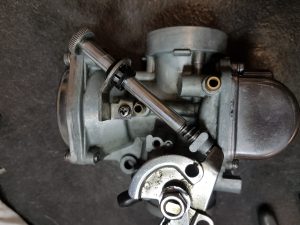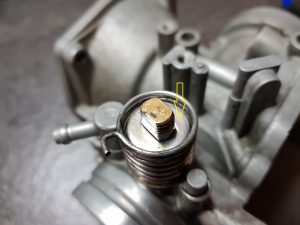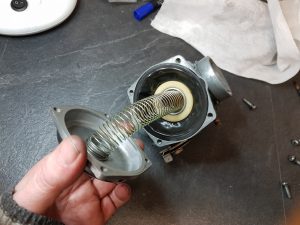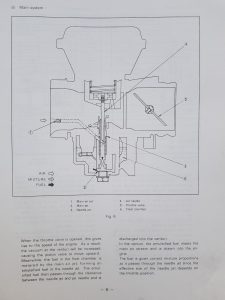Left butterfly valve assembly
As always, click on the images for detailed view.
Step 1
Add some grease on the both ends of the shaft.
Very much the same assembly as on the right carb ( see the post Right butterfly vavle assembly )
Step 2
Insert the seal with the lips facing outwards. Two seals, one for each end.
Step 3
Insert the shaft and the butterfly valve. Secure the screws with loctite. Use new screws if they are worn.
Note, the text on the valve facing upwards (red arrow on the picture )
Make sure the valve sits well and is the correct position. If not you will get trouble later on doing the synchronization ( balancing ) of the carbs.
Step 4
Step 5
Most of the parts got some seconds or minutes on the polishing machine before mounting, the spring as well. Looks so much better.
Step 6
Step 7
Step 8
DONE !
Carburetor Top
Parts to be mounted in the carb top.
Click on images for detailed view.
The normal position of the circlip should be in the middle, not like the one on the picture. Adjustment can be done to get a better temperature on the spark plug. Do not change the original needle with an aftermarket one if the original is OK and not worn.
You can check the tension and length of the spring according to the service manual. It’s more important to check that all three spring has the same length. That will be important later on when you are doing the syncronization of the carbs.
Step 1
Use a flashlight and check the diaphragm for any leakages
HELP ! I found a hole. Have to get a new one….@#%%@@
Step 2
Get a new one and proceed.
Install the needle
Step 3
Install the cap ( needle plate )
Step 4
Add grease to give a tight seal against the diaphragm
Step 5
Install the diaphragm , note the position shown by the arrow.
Step 6
Mount the spring and the top cover.
Step 7
Test the diaphragm by pushing the piston up and hold you finger above the intake hole.
The piston should stay stable, or move very slow. Release our finger and the piston shall go down.
Step 8
Done 🙂
Float chamber assembly
Float chamber
Click on the images for detailed view.
The picture above shows all the part in the float chamber
Step 1
Install a new gasket. Some of the aftermarket kit might require some trimming of the gasket. If the original gasket is an a good shape, keep it and don’t replace it.
Install the needle valve. Don’t forget the washer.
Step 2
Clean the needle jet before mounting using brush, carb cleaner and compressed air.
Replace the O-ring.
Step 3
Mount the needle jet and the float.
You can easily check the function of the valve by blowing air from you lungs into the fuel inlet and hold one finger on the outlet on the other side. By lifting the float up and down you will sense if the flow turn on and off when the valve is activated.
Step 4
Adjust the height of the float by measuring from top of the float and down to the chamber attaching face. Not down to the gasket as it’s done on the photo. Open the Suzuki carburetors service manual for more information. Yes, you find it on my blog.
If the original needle valve is used the height should be 27,6 mm .Some of the aftermarket needle valve should be adjustet to 26mm due to a bit different design. Do the adjustment by bending the tab touching the needle valve.
Tilt the carb about 15-20 degrees to avoid the gravity to influence on the float and the needle while you do the measurement.
Step 5
Installing the main jet.
The correct size is 110 for the right and left carb. 107,5 for the center carb.
Step 6
Installing the pilot jet
Screw in the pilot jet. Firm, but do not over tighten.
Standard jet size is 47,5. The jet in the picture above is 45 and is probably installed because the bike has been importet from US. Emission laws in CA were more strict compared to Europe and they used diffrent jets. I fitted the one from the aftermarket kit with the correct 47,5 size
Step 7
Install the drain plug ( and the washer )
Fit the float chamber with the four screws.
Jet cleaning
Before using carb cleaner and compressed air wash the carburetor using brushes and if possible, use ultrasonic cleaner as well.
Main jet and Pilot jet
Spray carb cleaner or other type of solvent through the main jet and pilot jet. The main jet is 0,5mm and the pilot jet is 1mm. If anti surging jet is mounted (as on the picture) the pilot jet is reduced to 0,8mm
Clean well using solvent+compressed air and use a string at proper diameter for cleaning.
Pilot pipe cleaning
Mount the pilot screw before proceeding
Mount the pilot screw. Fully in, then 2/4 of a turn out again.
Cleaning
Spray carb cleaner into the pilot inlet. Make sure it’s a good flow throgh the output.
Fuel inlet
Clean the fuel inlet using a brush and carb cleaner. Use compressed air to clear.
Starter jet
Clean the starter jet as well. Hold your finger at the top and flush the jet. This can be quite often blocked.
Pressed in starter jet
Check to see you have a good flow through the pressed in starter jet.





























































